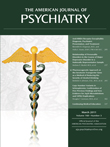The Association of Stigma With Violence
To the Editor: In their article published in the November 2010 issue of the Journal, Bernice A. Pescosolido, Ph.D., et al. (1) seemed perplexed that stigma associated with schizophrenia did not decrease among the general public between 1996 and 2006, despite evidence that people in 2006 had a better understanding that schizophrenia is a brain disease. The stigma, in fact, increased during this period—a continuation of a trend dating to the 1950s, as reported in a previous publication by these authors (2).
The reason for this trend is self-evident. Until the 1960s, most individuals with severe psychiatric disorders were hospitalized. Deinstitutionalization has now placed most of them in the community, and at any given time approximately half are untreated. In response to their delusions and hallucinations, a small number of these untreated individuals become violent. Both recent (3) and past (4) studies have reported that such individuals are responsible for approximately 10% of the homicides in the United States as well as other violent acts. Studies have also shown that when they are treated, they are much less likely to commit violent acts (5).
The major cause of stigma is thus violent behavior. As stated in the 1999 Surgeon General's report on mental health: “The answer appears to be fear of violence: people with mental illness, especially those with psychosis, are perceived to be more violent than in the past” (6). This is the elephant in the room that we don't like to talk about. We think that talking about it will increase stigma, yet if we don't talk about it, and take steps to ensure that individuals with serious psychiatric disorders receive treatment, we will never be able to decrease stigma. The public reads newspapers and watches television; they will believe what they read and see, not what we tell them they should believe.
1. : “A disease like any other”? a decade of change in public reactions to schizophrenia, depression, and alcohol dependence. Am J Psychiatry 2010; 167:1321–1330Link, Google Scholar
2. : Public conceptions of mental illness in 1950 and 1996: what is mental illness and is it to be feared? J Health Soc Behav 2000; 41:188–207Crossref, Google Scholar
3. : Characteristics of persons with severe mental illness who have been incarcerated for murder. J Am Acad Psychiatry Law 2008; 36:74–86Medline, Google Scholar
4. : The relationship of mental illness to homicide. Am J Forensic Psychiatry 1985; 6:3–15Google Scholar
5. ,
6.



